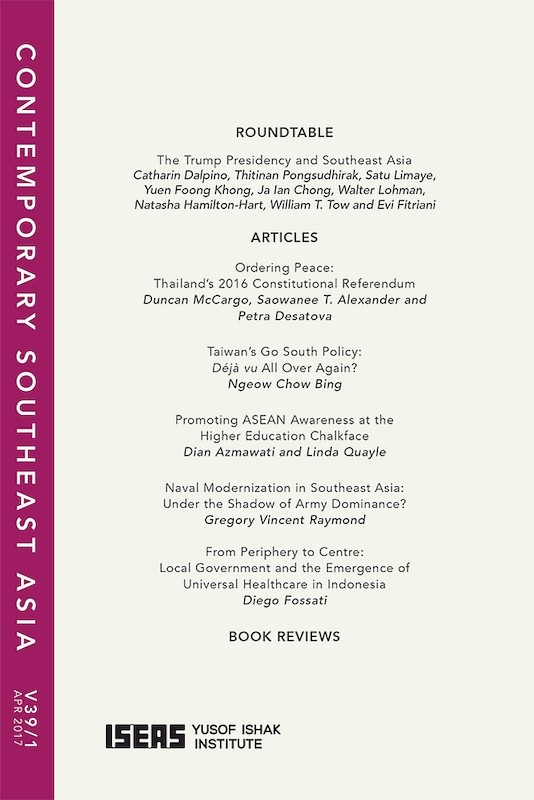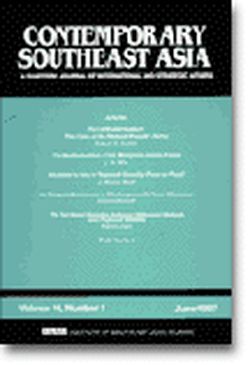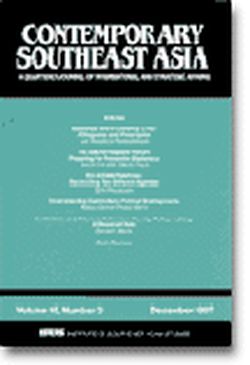Contemporary Southeast Asia: A Journal of International and Strategic Affairs Vol. 17/3 (Dec 1995)

Date of publication:
December 1995
Number of pages:
115
Code:
CS17/3
Contents
-
Preliminary pages
- ARTICLES
-
The Myanmar Army Since: Acquisitions and Adjustments, by Andrew Selth, author see abstractBefore 1988, the Myanmar Army was a lightly-equipped infantry force organized and deployed for internal security operations. Its heavier equipment was obsolete, its logistics and communications systems were weak and operations were hampered by shortages of transport, fuel and ammunition. Under the State Law and Order Restoration Council, however, the army has grown from about 170,000 to more than 300,000 men. This increase in manpower has been accompanied by a massive arms procurement programme, designed to modernize the army's weapons and equipment, and upgrade its operational capabilities. The Myanmar Army is now a much more formidable force but, until a number of serious problems are overcome, its capabilities will remain limited and its professionalism suspect.
-
The Political Economy of the Royal Government of Cambodia, by Ronald Bruce St John, author see abstractAfter more than two decades of severe economic dislocation, the newly-installed Royal Government of Cambodia understandably placed a high priority on the renovation and rehabilitation of the national economy. To accomplish this, it developed an ambitious, comprehensive plan which was presented in March 1994 to the International Committee for the Reconstruction of Cambodia. The plan called for the initiation of a wide variety of new economic development programmes and projects even as Cambodia sought to consolidate gains achieved from earlier economic reforms. The results of this approach in the first one and a half years of its implementation, a period which the Cambodian Government itself described as crucial to the longer term success of the plan, have been very mixed. Modest success in some economic policies and sectors has been accompanied by less than desirable results in others. More importantly, the checkered progress achieved in the economic sphere has not been accompanied by similar advances in the political arena. The failure of the government to support and build upon the democratic precepts and institutions outlined in the 1993 Constitution threatens to undermine the entire economic development process.
-
The Political Economy of Taiwan's Relations with Southeast Asia: The "Southward Policy", by Samuel C Y Ku, author see abstractWhen President Lee Teng-hui and Premier Lien Chan visited Southeast Asia in early 1994, Talivan's "Southward policy" began to be known world-wide. Superficially, this policy is aimed at strengthening Taiwan's economic relations with Southeast Asian countries, but in reality the ROC Government intends to expand Taiwan-Southeast Asian economic linkages in exchange for Taiwan's political participation in regional organizations and activities. Yet, while Southeast Asian countries welcome Taiwan's economic resources (capital and technology), they hesitate to upgrade their political relations with Taiwan owing to their deference to China. This article suggests that while Taiwan exerts efforts at strengthening its relations with Southeast Asia, it should also promote practical relations with mainland China. In addition, the "Southward policy" should be seen as a long-term objective instead of a short-term programme.
-
Vietnam and Its Neighbours: The Border Dispute Dimension, by Ramses Amer, author see abstractThis article deals with the current active border disputes between Vietnam and its neighbours. It discusses Vietnam's position with regard to the convicts with individual countries, and its overall attitude towards border disputes. Vietnam has active border conflicts with Cambodia, China, Indonesia, Malaysia, the Philippines and Thailand. It favours formal negotiations with the goal of resolving these disputes, stressing that they should be handled through peaceful means, and that the countries concerned should refrain from the use of force. Vietnam's recent accession to membership of ASEAN is likely to make the conflicts with its fellow ASEAN members more manageable. Hanoi will contribute to the strengthening of ASEAN's overall policy of promoting regional integration and co-operation. With regard to the ongoing process of dialogue relating to the Spratly conflict and to other disputed issues in the South China Sea, Vietnam's membership will not alter the ASEAN position but rather give the grouping additional clout.
-
Interactive Naval Developments of Three Northeast Asian States, by Renato Cruz De Castro, author see abstractThis article discusses the dynamics of naval developments by three Northeast Asian states and how this might affect regional stability. It argues that China's naval force modernization cannot be adequately explained without looking at its regional context. It notes further that China's modernization programme is a response to the more advanced arms modernizations being implemented by its two neighbours, Taiwan and Japan. The article concludes by arguing that China's build-up of its naval and air forces is occurring within an emerging arms race in Northeast Asia.
- BOOK REVIEWS
-
BOOK REVIEW: Pacific Cooperation: Building Economic and Security Regimes in the Asia Pacific edited by Andrew Mack and John Ravenhill, by Kenneth Christie, author
-
BOOK REVIEW:- Buying Power: The Political Economy of Japan's Foreign Aid by David Arase, by Lam Peng Er, author
-
BOOK REVIEW:- "A Strong Showing" : Britain's Struggle for Power and Influence in South East Asia1942-1950 by Rolf Tanner, by Malcolm H Murfett, author
-
BOOK REVIEW:- Fostering an Indigenous Defence Industry: Defence Industry Policy After the "Price Review" edited by Graeme Cheeseman, by Doug Thompson, author
-
BOOK REVIEW:- Sri Lanka: Militarisation and Modernisation by J Basil Fernando, by V Suryanarayan, author
-
BOOK REVIEW:- Essays on Strategy VIII edited by Thomas C Gill, by Miles A Baldwin, author






